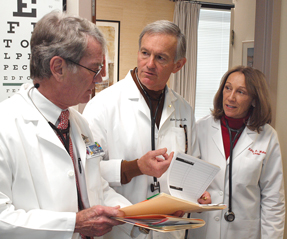Medical home model might be health care's next great change
The patient-centered medical home might be health care next transformational innovation, one that will allow primary care to survive and thrive.
After speaking to many different audiences in my time as ACP president, I realize more than ever that, as internists, we have a unique perspective on the true crisis in medicine that we face in the U.S. today. In 2010, we saw both the historic passage of the Affordable Care Act and an election in which a frequent pledge was to repeal and replace that act.
These are heady times, a crossroads in American medicine that I feel may be similar to the times around the release of the Flexner Report 100 years ago by the Carnegie Foundation. Abraham Flexner, a research scholar at the Carnegie Foundation for the Advancement of Teaching, undertook an assessment of medical education in North America, visiting all 155 medical schools then in operation in the United States and Canada. His 1910 report, addressed primarily to the public, helped change the face of American medical education.
The power of Flexner's report derived from his emphasis on the scientific basis of medical practice, the comprehensive nature of his survey, and the appeal of his message to the American public. Although reform in medical education was already under way, Flexner's report fueled change by criticizing the mediocre quality and profit motive of many schools and teachers, the inadequate curricula and facilities at a number of schools, and the nonscientific approach to preparation for the profession, which contrasted with the university-based system of medical education in Germany. Nearly half of American medical schools closed or merged following his report. Tremendous scientific advances using a more European model of education and practice followed.
After a visit to the Royal College of Physicians in London in 1913, Dr. Heinrich Stern tried to invoke enthusiasm in his colleagues for a similar organization in the United States. But it was two years before Dr. Stern could gather the number of other physicians—11—that he felt necessary to launch the new organization, the American College of Physicians. From the College's first formal meeting in New York's Astor Hotel on June 25, 1915, the founding members viewed ACP as a way to improve the standards and recognition of internal medicine in this country.
As ACP has grown from 12 to over 130,000 members, we can look to Europe and the rest of the world for guidance. We will once again forge our unique American way, as the noted observer of all things American, Winston Churchill, once said: “You can always count on Americans to do the right thing, after they've tried everything else.”
As I travel and study, I have come to believe that most patients who have a primary care physician do not realize how perilous that relationship might be. If that physician dies, retires, becomes ill, or finds that economic pressures force him or her to leave practice, then those patients currently content with our health care “system” may become acutely aware of the growing shortage of primary care physicians in a very sobering manner.
Many Americans feel invincible and therefore have not sought out a primary care doctor. They fully expect that one will be available should the need arise. In general, an ample supply of primary care physicians appears to be associated with better health outcomes and lower costs, yet our physician workforce is “underbalanced” in this key area at a time when the baby boomer generation is beginning to hit peak years of medical needs.
The patient-centered medical home (PCMH) appears to be a transformational medical delivery model that should appeal to everyone as it develops and is better understood. Initial reports show improved patient satisfaction in the PCMH. Payers are noting that some PCMH practices are able to reduce the cost of care for their patients in comparison to non-PCMH practices. This is a remarkable finding in an era when health care costs generally trend upward in spite of everything we do.
Initial reports of PCMH demos show primary care doctors and other health professionals happier in a new practice world. I am particularly heartened to hear of doctors canceling their plans for retirement because they are again able to do what they went into medicine to accomplish.
The devil will of course be in the details, but comorbidity adjustments allow more flexibility for appropriate payment depending on the complexity of various patients and clinical situations. Dynamic methods for assessing the impact of the PCMH model on quality and cost should be used so that we can identify valuable innovations and modify others if they do not result in better outcomes.
Under the PCMH, payment should allow adequate investment in staff and information technology to provide the time and resources for proper evidence-based care. Hopefully, insurers and employers will respond to our calls for reduction and/or elimination of the many hassle factors for practices, demonstrating efficient use of resources and appropriate use of technology.
We need to discuss among ourselves and embrace an evidence-based approach to health care reform where at least certain elements could be as nonpolitical as the best treatment for hypertension or diabetes. We need to engage our patients, business leaders, insurers, and elected political leaders in a dialogue to allow us to keep what is great about American health care when it is needed. We need to focus on prevention and early treatment for everyone, and hopefully we will then need less interventional treatment. This should allow us to better afford evidence-based prevention and treatment for everyone.
Small business needs this to survive. Larger businesses need it to compete in our global economy. Our patients need and want affordable care, and hopefully we can help them better understand the changes we must accomplish to make this happen. If we succeed, it will be wonderful news to families with tight budgets, small businesses struggling to meet payroll, and large companies in an increasingly competitive world economy. The PCMH appears to be a key element of the transformation that is needed to bend our health care cost curve.
It's a new year. Let's get to work!




